Kabbalah and Architecture - Faith and Form
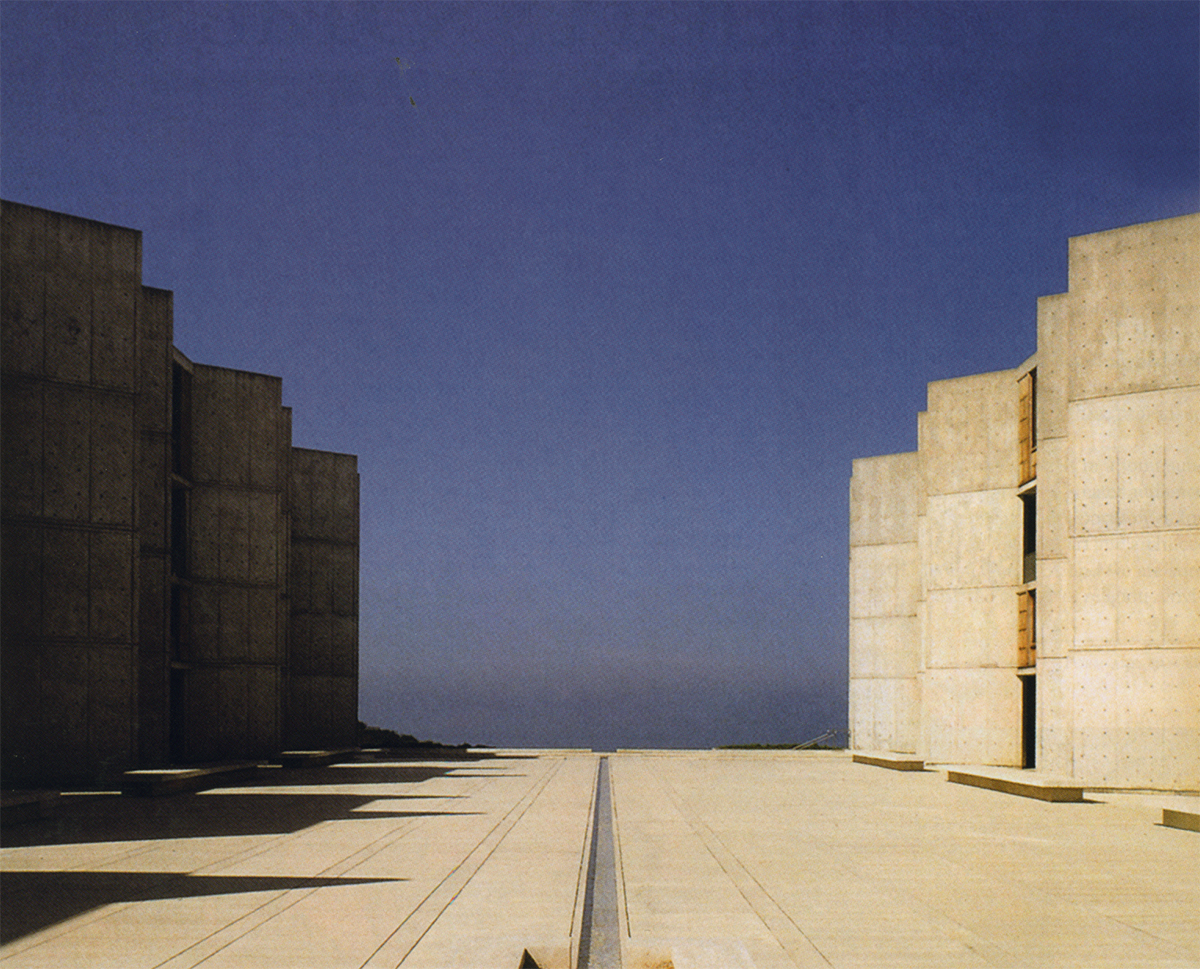
Louis Kahn's Salk Institute expresses Kabbalaistic themes.
Kabbalah, and the mystical aspect of Judaism, dates back to the Middle Ages. It means tradition in Hebrew: what is received, and was ignored with the rise of a more rational Rabbinic Judaism in the 19th century. It is theosophy, a theory of the elaborate structure of the Divine world and how humanity is connected to it. As Adin Steinsaltz writes in The Thirteen Petalled Rose, the Kabbalah's multiple worlds are all intricately interconnected, and as in Hindu karma, deeds have reverberations throughout creation. Many of its concepts touch upon concerns of modern mankind, e.g., Tsim-tsum: the absence of God and the presence of the void; the Breaking of the Vessels: the chaos of the world, recalling Derrida's deconstructionist theories; the transformative power of light and Tikkun: the moral obligation to restore the equilibrium of the world, with echoes of sustainability and green architecture.
Traditionally, the study of Kabbalah was limited to married men over the age of 40. Outside the closed world of Orthodox Jewish culture that certainly has changed, with a world hungry for spiritual guidance in a previously little-known discipline. Celebrities such as Madonna and Britney Spears have popularized a mode of Kabbalah that is noticeably short on scholarship, but that is not the subject of this article.
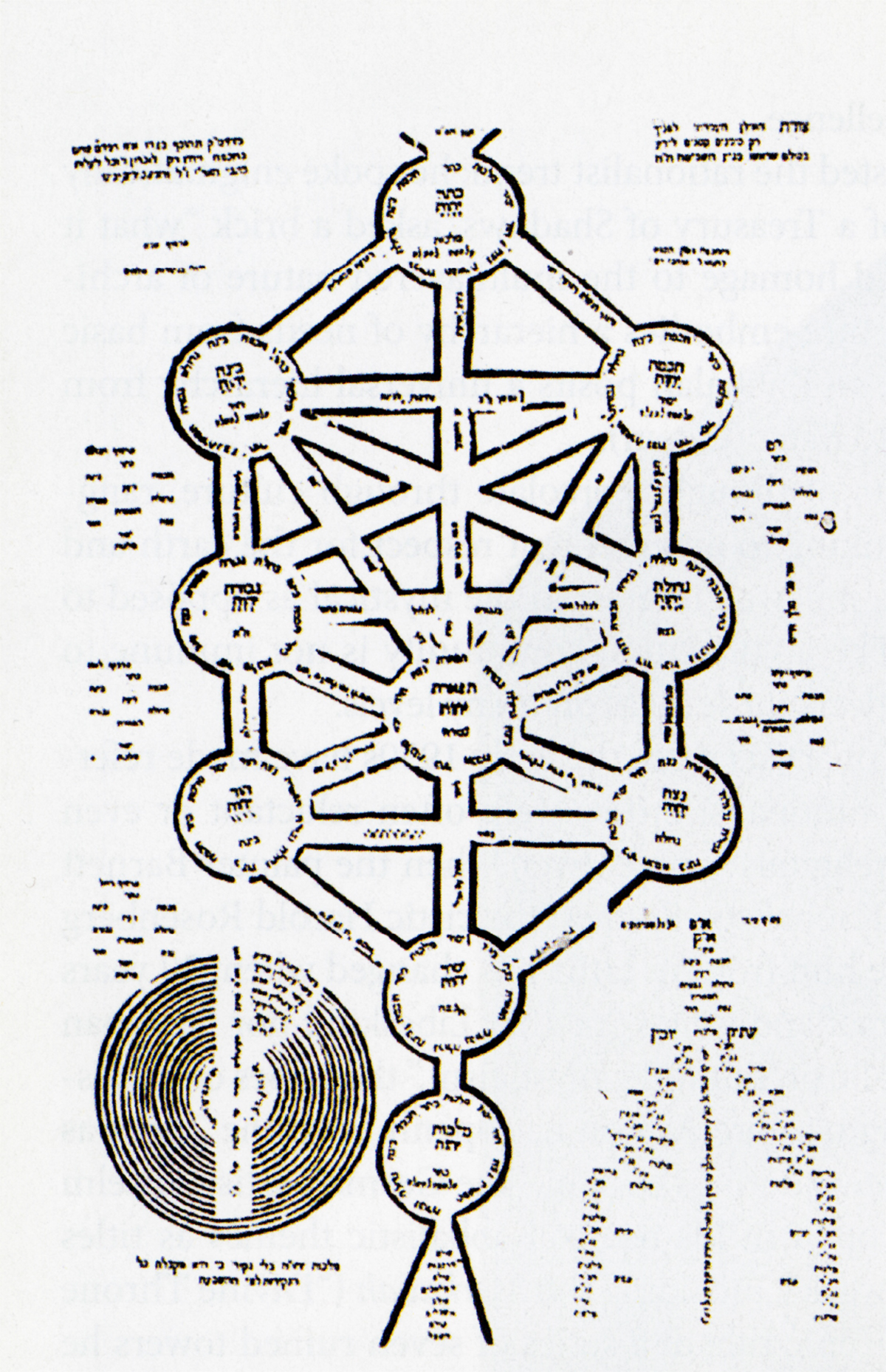
Representation of the Sefirot.
Even noted architects such as Frank Gehry and Steven Holl are willing to discuss the influence of Kabbalah on their work. Gehry claims that he "tried studying the Zohar, but it was too difficult;” though earlier in his youth he studied the Talmud. He suggested that I talk to his friend Margot Pritzker (of the Pritzker Prize family), who has funded a new translation of the Zohar (a series of books written in Aramaic that constitutes a mystical commentary on the Torah). I explained to Steven Holl the difficulty of distinguishing between the intentional use of Kabbalah and the use of these concepts when projects do not have a Jewish program, such as in his Chapel of St. Ignatius in Seattle, clearly a "vessel of light;' a Kabbalistic concept. Hall admitted that he studied the works of the Kabbalah scholar Gershom Scholem in preparation for the design. Daniel Libeskind is very specific in regard to Kabbalistic references in his new Jewish Museum of San Francisco. Certainly then, both implicitly and explicitly, Kabbalah has a place in the making of architecture that is now more public than ever before, paralleling the rise of Jewish identity in the other arts. From Louis Kahn to Stanley Tigerman, who has written extensively on the topic, what was once left unsaid is now open to debate.
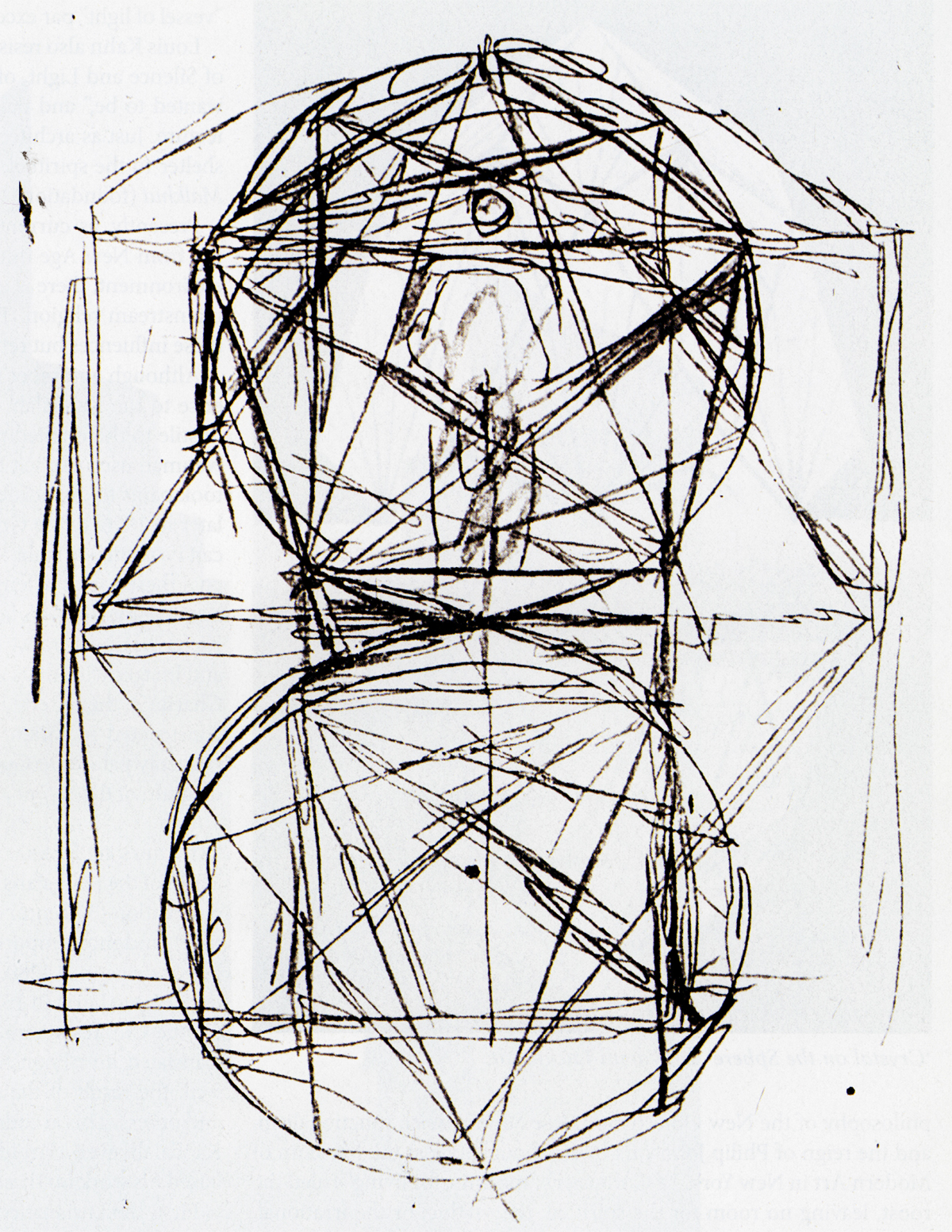
Le Corbusier's sketch of the chapel at Ronchamp.
My interest in Kabbalah arose as a result of the charge to design a synagogue in Kings Point, New York. One of my sources of inspiration was the history of synagogues. In the 19th century the synagogue adopted an inappropriate historicist style such as Byzantine, often assigned by government authorities. As Jews were often expelled from one place to another, it was difficult for them to establish an authentic style of their own. This lack of a historic tradition of Jewish architecture, apart from Polish wooden synagogues, encouraged me to seek out texts of the Old Testament. Noah's Ark, the Tabernacle in the desert, the Temple of Solomon, and the prophet Ezekiel's Vision of the Temple are all described in great detail, including dimensions and materials. These are, however, literal descriptions, as opposed to the more abstract concepts from the Kabbalah, which are more open to interpretation in a modern sensibility.
KABBALAH AND WESTERN ART AND ARCHITECTURE
Embedded in the Jewish mystical tradition of Kabbalah is a strong connection with the primal concepts of architecture; space, light, and geometry. Many of its texts were translated and presented to the English-speaking world early in the 20th century through the scholar Gershom Scholem, and were thus available to a wider audience only recently. However, in the late Renaissance, an interest in Kabbalah among Christian philosophers helped circulate images and ideas that eventually found their way into intellectual circles late in the 19th century. These included the Theosophical Society, of which Piet Mondrian was a member, William Yeats and his interest in the Order of the Golden Dawn, and the Russian mystic Georgi Gurdjieff and his pupil, Olgivanna Wright.
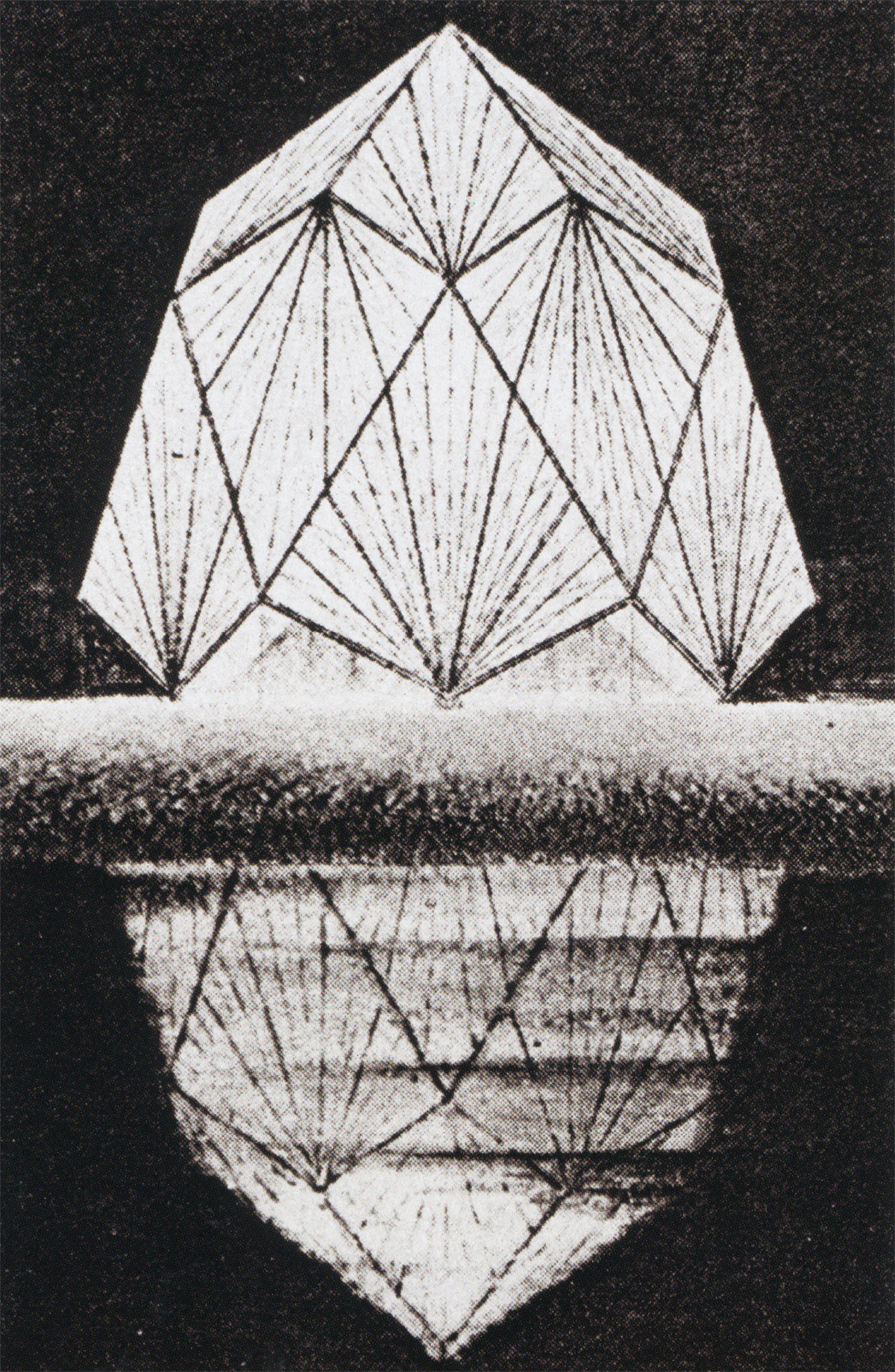
'Crystal on the Sphere' by Wassili Luckhardt.
It is exactly this lineage that explains why the architectural implications of Kabbalah have long been suppressed. Modern architecture triumphed finally through the rationalist philosophy of the New Objectivity (Neue Sachlichkeit), functionalism, and the reign of Philip Johnson's International Style at the Museum of Modern Art in New York. Le Cor busier's "machine for living" ruled the roost, leaving no room for the spiritual, the mythic, or the irrational. The automobile, boat, and airplane from his Towards a New Architecture were elevated to transcendent level. While in the world of art Cubism and Surrealism thrived by reconnecting to the primitive past of mankind, canonical modern architecture's relentless emphasis on functional and structural aspects eventually limited its relevance to all but commercial office buildings by the late 1950s and 1960s.
Le Corbusier, whose own work gradually changed to reflect his growing disillusionment with the machine, subsequently incorporated multiple mystical themes. He referred specifically to the Kabbalah in his book of 1947, When the Cathedrals Were White. In discussing the Middle Ages, he wrote: "human beings observed the hermetic rules of Pythagoras- searching for the law of harmony. The law of numbers was transmitted from mouth to mouth among initiates, after the exchange of secret signs. The Tour Saint-Jacques in Paris is a gigantic rebus worked out on the basis of the Cabala.” Le Corbusier would have known about the mystical Sefirot diagram from his profound interest in alchemy, which absorbed Kabbalistic themes towards the end of the 16th century. Perhaps this explains the presence of a sketch that approximates the Sefirot at the end of his own book on the Chapel at Ronchamp, itself a "vessel of light" par excellence.
Louis Kahn also resisted the rationalist trend; he spoke enigmatically of Silence and Light, of a Treasury of Shadows, asked a brick "what it wanted to be;' and paid homage to the multilayered nature of architecture. Just as architecture embodies a hierarchy of needs from basic shelter to the spiritual, so Kabbalah posits a universal hierarchy from Malkhut (foundation) to Keter (crown).
Presently, as currents of thought percolate through culture, ranging from New Age thinldng to an emergent respect for the earth and environment, there is a renewed interest in the mystical as opposed to mainstream religion. The architectural community is not immune to these influences but reflects these ideas on many levels.
Although a number of artists since the early 1950s have made reference to the Kabbalah, rationalist critics were often reluctant or even hostile to the implied religious source. Even when the painter Barnett Neuman used explicit Kabbalistic themes, the critic Harold Rosenberg took pains to dissociate him from it. Little has changed when, 30 years later in 1996, Arnie Graafland writes "neither Libeskind nor Newman can be related to Kabbalic or Talmudic mysticism;” then goes on to discuss these topics at length! Dore Ashton has openly cited the Zohar as a source for Rothko's late paintings of light. The German artist Anselm Kiefer has been most open in his use of Kabbalistic themes as titles and images within his works, including the Merkabah ("Divine Throne Chariot"), the bitterly ironic title of a series of seven ruined towers he constructed in Milan. Sefer Hechalot, the ascent through the seven heavenly palaces to God, is the title of a series of his paintings, and the diagram of the Sefirot appears numerous times in other works.
CONCEPTS OF KABBALAH
Three of the Kabbalah's most important texts are: the Sefir Yestirah, Book of Creation (3rd century), the Sefer Bahir, Book of Brightness (10th century), and most important, the Zohar, Book of Radiance, attributed to Moses de Leon in 1280. Equally important for our purposes is the teaching of Isaac Luria in 1550. There is no single Kabbalistic text as there is for the Old Testament, and few of those extant have been completely translated into English. Our interpretations are therefore received as well, the result of the scholarship of Gershom Scholem, Moshe Idel, and others. This accounts for the fragmentary and ambiguous world of Kabbalah; even Harold Bloom, in his famous Kabbalah and Criticism, based his work on these scholars' thinking.
First, the Lurianic conception of creation deals with the time before the first lines of Genesis, and posits the answer to the question: If God is everywhere how can there be room for creation? Before creation was Ein-sof, the infinite void. Astoundingly, rather than an active gesture of creation, there is a self-limitation, a contraction of God within himself called the Tsim-tsum. This withdrawal creates a vacuum within the infinite space of Ein-sof, from which a single beam of light splits open the blackness of the void; it then bounces back and forth across Ein-sof until it finally manifests itself as the Sefirot, the ten emanations of God. As Moses Cordovero wrote: "The Infinite, the King of Kings, who rules all: for his essence penetrates and descends via the Sefirot and between the Sefirot.. . "
The Sefirot of light is an immensely important concept that is portrayed as the structure of the Divine in a geometric treelike diagram of force and light. This network of forces is balanced left and right between, for example, Hesed (mercy) and Din (judgment) and up and down, Keter (crown) and Malkhut (foundation). There is an anthropomorphic dimension to the Sefirot that recalls Kundalini yoga, where just as in the Sefirot, the chakra points correspond to different parts of the human body.
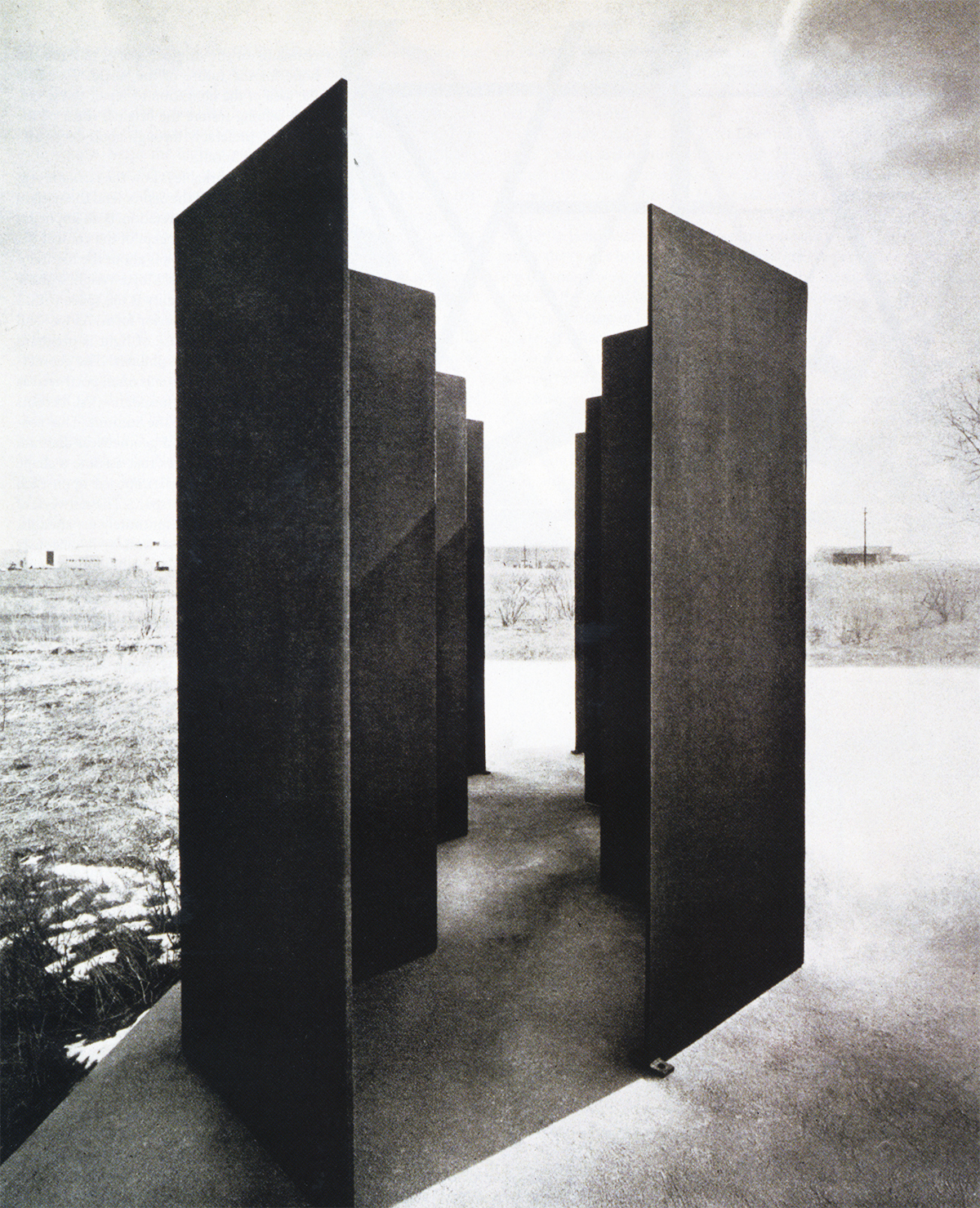
Barnett Newman's 1969 sculpture, 'Tsim-tsum.'
These initial lights from the time of creation that emerge from the void of Ein-sof then flow into a series of vessels or bowls of light that shatter because the light that they receive is too intense. This catastrophic event is Shevurat Hakelim, the Breaking of the Vessels, symbolizing the breaking of the order of the universe. Miraculously, the shards of the vessels retain remnants of the original sparks of light, the hope for the future of the world. Tikkun is the idea of the obligation to repair the world, thus helping restore the original order of the universe, preferably through good deeds and study of the Torah.
What is remarkable is how the Lurianic creation concepts and the Sefirot lend themselves to architectural interpretation, both implicitly and explicitly. The concept of the void, at the heart of the Tsim-tsum, is about the nature of space, recalling Frank Lloyd Wright's quote of Lao Tze that the reality is the space within the vessel, not the exterior form. As we shall see, the Kabbalistic use of light is pregnant with architectural possibilities. The geometric diagram of the Sefirot is often portrayed as a tree, with Malkhut (foundation) at its roots and Keter (crown) at the summit. This cosmic tree is shown in a geometrical diagram of interconnected lines that assume a shape of flattened cubes superimposed upon each other, expanding into space. The network of cubes is also drawn as infinitely expandable, into the many Divine worlds; it curiously resembles hypercubes and other modern cosmological diagrams.
KABBALAH AND THE EXPRESSIONIST MOVEMENT
Although a number of contemporary architects have noted Kabbalah as an inspiration for their work, less known is the potential relationship of Expressionist architecture to Kabbalah early in the 20th century. The circle of architects known as the Glass Chain that included Bruno Taut was inspired by the poet Paul Scheerbart, who infused the material of glass with the spiritual and mystical attributes that would elevate and purify society. He wrote, "Light seeks to penetrate the whole cosmos / And is alive in crystal.” The mystical ideas related to the crystal metaphor have been shown by Rosemarie Bletter to derive originally from the apocryphal tales of King Solomon and his throne of glass, and from the crystal throne chariot of Ezekiel’s vision, the direct source of Merkabah mysticism and the precursor to the Kabbalah. The historian Gershom Scholem lived in Berlin at the time of the group's formation; he was not only an admirer of Scheerbart, but alone collected all Scheerbart's writing and took it to Israel in 1923. Scholem was also a close friend of Walter Benjamin and introduced Benjamin to Scheerbart's work in 1917. Hans Polzeig, another Expressionist, did the sets for the silent film, The Golem, based on the Kabbalistic idea of a clay sculpture of a man brought to life by the mystical name of God.
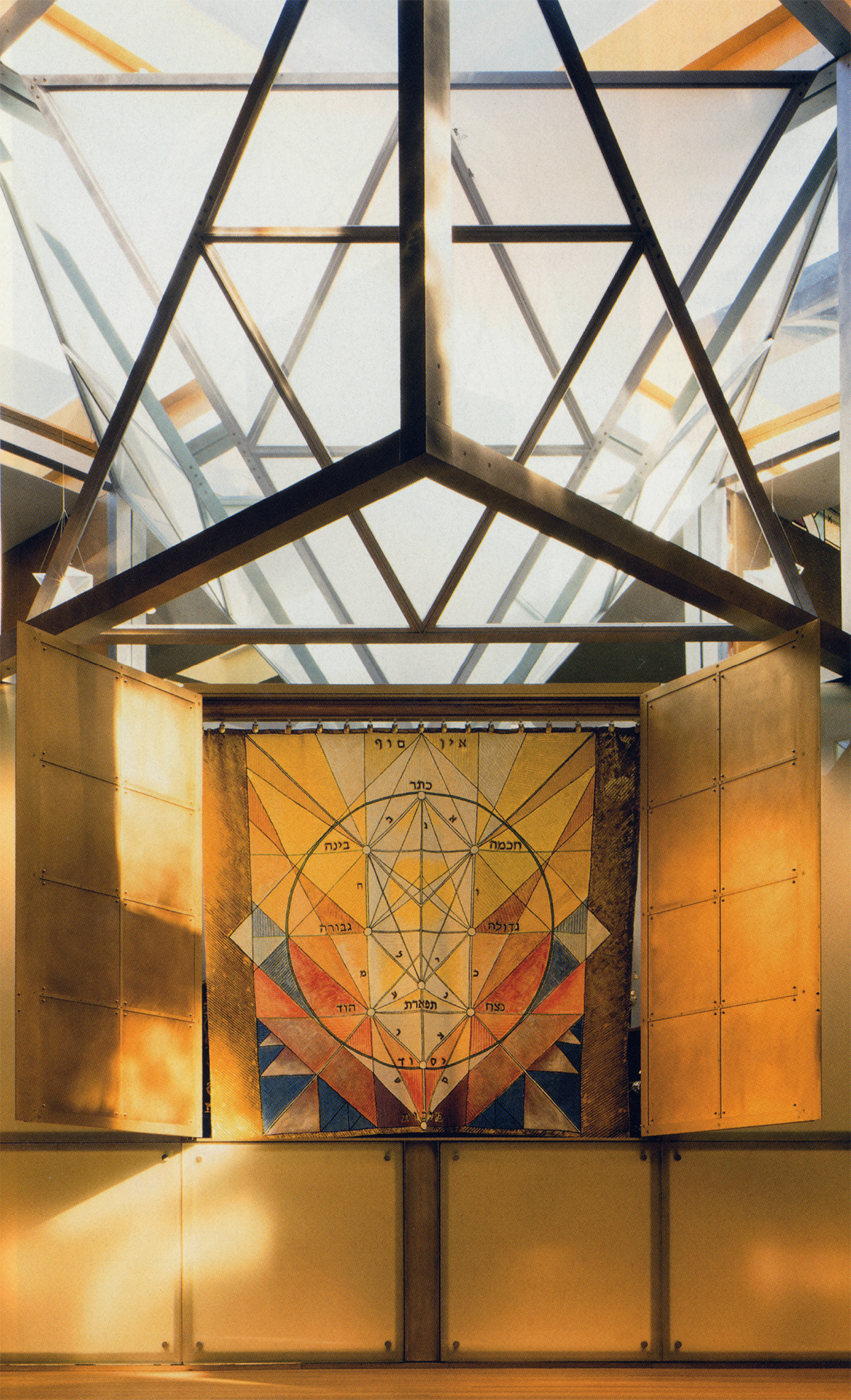
North Shore Hebrew Academy, designed by the author.
The other theme of the Glass Chain group was the Stadtekrone, the City Crown: that a city should focus on an important and inspiring structure of height and bold design. This was the idea of the architect Bruno Taut, who dedicated his Glass Pavilion to Scheerbart and included a drawing of the Temple of Solomon in his book. The crown of light is, of course, Keter, the highest point of the Sefirot. It is a tantalizing question whether Scholem and Scheerbart discussed this congruence of meaning, especially as Scheerbart's ideas about glass had strong religious overtones. Taut included in his magazine Fruchtlicht writings by the Christian mystic Meister Eckhart who lived at the time of the writing of the Zohar and talked about the sparks of light in the soul. As for the architectural images that were produced by members of the group, Frank Gehry has cited the swirling forms of Finsterlin as the precedent for his museum at Bilbao, a Stadtekrone if ever there was one, and a veiled Keter as well. The plan of Bilbao in fact resembles a rose, the flower mentioned in the very first lines of the Zohar: "For there is a rose, and then there is a rose!"
Frank Lloyd Wright's relationship to mysticism is well documented through his wife, Olgivanna (a devotee of Georgi Gurdjieff) whom he married in 1925. In 1926, Wright designed the Steel Cathedral for William Guthrie in New York City. A 2,100-foot-high space for the worship of the "universal religion;' Wright's description is straight out of Scheerbart: "iridescent by day, luminous by night, imperishable! Buildings, shimmering fabrics, woven of rich glass, glass all clear or part opaque and part clear, patterned in color:' This Wright project takes on great meaning as the direct precedent for his only synagogue design, Beth Shalom near Philadelphia. It is a modified hexagonal Star of David in plan and is triangular in section; the client, Rabbi Mortimer Cohen, called it a "Mount Sinai of glass;' the embodiment of Keter, the Crown.
THE TSIM-TSUM AND THE RAY OF LIGHT
Barnett Neuman, the Abstract Expressionist artist of the early 1950s, made direct reference to the Kabbalah in painting, sculpture, and a synagogue project of 1963. Two side walls are broken by a folded wall of glass that he calls the Tsim-tsum, presented in the Jewish Museum synagogue exhibition curated by Richard Meier, who has yet to design a synagogue. Within this folded wall, light is refracted and bounces back and forth, an analogy of the Tsim-tsum, where light emerged from the void of darkness. Inside, in an ironic secularization, the bimah or reader's platform is a pitching mound, and the seats are called dugouts. It is not completely unreasonable to interpret the act of being called up to the bimah (to face God) as similar to a baseball batter's face-off with his pitcher.
Neuman's Tsim-tsum sculpture of 1969 isolates a folded wall into a free-standing sculpture of two zig-zagging folded sheets of steel that frame the empty space between. One half of the sculpture echoes the plan of Daniel Libeskind's much later Jewish Museum of Berlin. The void in the Tsim-tsum sculpture strongly recalls the central space framing the blue sky and the Pacific Ocean of Louis Kahn's Salk Center in La Jolla. This central court is also split by a narrow channel of water emerging from a cube of travertine, like the rock struck by Moses from which issues water (Exodus, 17:6). The reflection of the setting sun in the channel creates a vertical strip of light, the luminous line rips through the void of the night to recreate the myth of the first ray of light, recalling Neuman's Onement painting.
Kahn made specific reference to the Kabbalah in the plan of the Mikveh Israel synagogue, first pointed out by Jeffrey Kieffer, where the ten nodal points of the Sefirot became circular towers of light reflecting light back into the space of the sanctuary. Kahn often referred elliptically to ancient Jewish sources: to the nine-square plan interpretation of Ezekiel’s Vision of the Temple in the Hurva Synagogue in Jerusalem (1968-1972), and in his glass-cubed Holocaust Memorial for New York (1964-1972). He referenced Polish wooden synagogues in his Temple Beth-el in Chappaqua, New York.
Both Daniel Libeskind and Peter Eisenman use the concept of "void space" in their architecture where Jewish themes are present, especially in their Holocaust memorials. In Libeskind’s Jewish Museum of Berlin, the void tower symbolizes the Holocaust, and the implied withdrawal of God, identifying the Tsim-tsum with the temporary triumph of evil. In his Berlin Holocaust Memorial Eisenman creates a field of sliced forms where the spaces between the cubic blocks are the paths for experiencing the monument. Again, the emptiness of the "negative space" is the field for the crimes of the Nazi era, using Tsim-tsum as metaphor. In his War Museum in Liverpool, Libeskind literally uses the concept of a shattered sphere, its shards in disarray, as the form of the museum and a literal interpretation of the broken vessels, this Kabbalistic reference pointed out by Charles Jencks.
Returning to my own work at the North Shore Hebrew Academy, the synagogue design made a virtue of the necessity of burying most of the building's form by animating the design with the concept of the "Breaking of the Vessels” The interior space appears to be bursting with light, and is focused on a cube of light over the ark, with clerestories emanating from this central point. The cube is fractured by two triangles that evoke not only the Star of David, but also the diagram of the Sefirot, which also informs the pattern on the curtain in front of the ark.
The field remains wide open, with the excitement of the unearthing of a new mine of inspiration and new worlds to explore in space, form, and light.